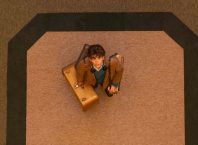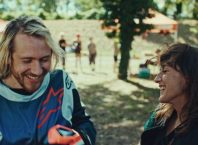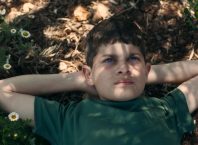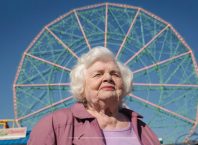By Shlomo Porath
This June has been a particularly bountiful month at the Jerusalem Cinematheque. I’ve probably seen more films in the past two weeks alone than I have in any single month since I’ve started my membership there (excluding the 10 intense days of the International film festival).
Along with the discovery and rediscovery of various gems, I also attended three films shown as pre-releases, films hat are set to be released to theaters in the coming weeks. The most interesting and exciting of the three was writer-director Henry Selick’s Coraline, based on the book by Neil Gaiman.
Being a big fan of both men’s work, I’ve been eagerly anticipating the film, which was released in the US to generally enthusiastic reviews this past March. It is a stop-motion animated film, where the animators go through the pain-staking process of moving small figures a fraction at a time, each fraction giving a single frame of actual film. Although it is an excruciatingly slow process, a major plus is that it seems to inspire a great deal of creativity in the details of every scene. One is used to such details in the similarly slow process of traditional and computer-generated animated films, but the rarity of feature length stop-motion films gives a film like Coraline an edge even on the beautifully created and rendered worlds of Wall-E and Kung-Fu Panda.
Director Selick is a modern master of stop-motion, having great success with The Nightmare before Christmas, where his work as director was overshadowed by Tim Burton, who originated the project. 2005’s The Corpse Bride, which was Burton’s next foray into the world of stop-motion (this time as co-director with Mike Johnson), illustrated precisely what Selick brings to a project as a director. The Corpse Bride looked quite good and extremely polished. So polished, in fact, that it might as well have been a computer animated film- all the kinks had been ironed out, all the jerky movements smoothed over. It made for an easily digestible and rather forgettable film- a very passive viewing. It missed the true strength of the stop-motion form: the immersive quality of the images, which is created by the knowledge that every single thing you are seeing (aside from some digital embellishments) was slowly and carefully crafted by a team of artists. This knowledge, even if received only subliminally, is evident in every single frame of Coraline. There’s nothing tossed off here- the density of the images is almost overwhelming. With every subtle move, every kink, one feels the artists at work. The film feels nurtured, and with so many films feeling like they were made by a committee of enthusiasts, this one deserves to be seen just for the care and artistry of it.
With Gaiman’s story, that vital and impassioned craftsmanship is put great use. It tells the tale of Coraline, a young English girl who has recently moved with her parents to an old country house that has been divided into three separate living facilities. An only child, Coraline is desperate for something interesting to do. Her parents are busy working on their computers and seem to have little interest in or sympathy for Coraline’s boredom. She spends some time with the eccentric neighbors, which include the voices of Ian McShain as the mouse-loving Slavic acrobat living upstairs and British comedy duo French & Saunders as former thespian sisters seriously stuck in the past, and goes exploring around the old house. The yields little of interest…except for that little door in the living room. During the day, there is a brick wall on the other side of the door. But when Coraline is awakened one night and opens the door, the wall is gone, to reveal a tunnel. Coraline goes through the tunnel, only to emerge at a place very similar to the house she left. But in contrast with the drab and gray living room she came from, the room she’s in now is a cozy room that is bathed in warm colors. Coraline hears her mother’s voice in the kitchen and follows it to find someone similar to her mother. This figure is preparing a delicious meal, and is fascinated by everything Coraline has to say. Also, she has big black buttons where her eyes should be. She explains that she is the Other Mother, and promises Coraline anything she wants. All she asks in return is for Coraline to show her love to her by sewing buttons on her eyes (whatever color she pleases).
With this premise, Gaiman explores some classic childhood themes, like selfishness, abandonment, and children and parents misunderstanding and underrating each other’s presence. But this predictability of theme is deceptively simple. For the younger readers that the novel is ostensibly aimed at, it may read like a wicked morality tale, something akin to a Roald Dahl tale. For older readers, the story is a chilling and devilishly creepy evocation of primal fears and wants.
From the opening credits, Selick vows to keep this intact in his adaptation. The credit sequence begins with a doll of a girl. A bit ragged, but it looks like a time-worn bit of nostalgia. We then see a fleshless hand, made entirely of needles, methodically take the doll apart, turn it inside out, and stitching it back up. It’s a deeply creepy sequence. I mentioned density earlier- 2 minutes into the film, and Selick has already perfectly laid out the themes he’ll be touching and methods he’ll be using. The scene is accompanied by a score by composer Bruno Coulais, the main element of which is a children’s choir singing gibberish words to delightfully mischievous melodies.
Being entirely visual, the sequence is not from the book, and is one of the surprisingly many changes between the film and book. After converting Coraline and her family from English to American, most of the changes work to make the film bigger and more visual than the book. There is more business outside of the house (including a most elaborate garden), which is quite welcome. However, not all of the changes are for the better. There is an addition of a side-kick that doesn’t really add a great deal, and especially a tweaking of the ending that steals some of our main character’s thunder when she sorely needs it. The character of Coraline loses more than a little in the translation to the screen- the broadening of the world and the dazzling visualization take some of the focus from Coraline, making her character seem less vivacious and interesting than in the book. Although Dakota Fanning does a fine job voicing Coraline, she simply cannot compete with the extravagance of the voice work provided by Terry Hatcher as mother and Other Mother, nor with French, Saunders, or McShane (though anyone would have trouble competing with his voice).
But at the end of the day, these caveats are forgivable given the richness of the film as a whole. I didn’t yet mention a stunningly realized circus show, performed by mice, as well as a mid-air recitation of a soliloquy from Hamlet, which includes the characters literally stripping away their old age and emerge as their shapely younger selves. And these are but stepping stone on the way to the conceptually beautiful sights of the climax, which is hard to properly describe. I’ve used enough hyperbole already. I don’t believe you’ve ever seen anything quite like this film before.






Comments are closed.